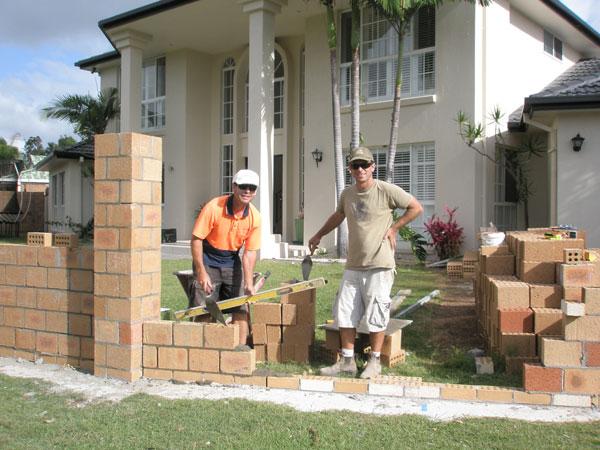Hire local retaining wall builders
Where do you need retaining wall builders?
Everything you need to know about finding a Retaining Wall Builder
Retaining walls are a great way to add visual interest to a garden or to create separate levels on a sloping block in order to maximise the usable garden space.
Considerations When Building Retaining Walls
When building retaining walls, there are some things that you need to watch out for to ensure that it is stable and functional. These include:
-
Choosing the right materials for the wall and the situation it is being used in
-
If you need a structural or decorative wall
-
Ensuring that the placement is correct – it is both expensive and difficult to move retaining walls
-
Ensuring that drainage from behind the wall is sufficient so that there is no pressure on the wall from water build up
-
Choosing the correct foundations for optimum stability
-
If using a structural wall, ensuring that the wall slopes backward slightly – this provides extra stability
 ©CDT Enterprises
©CDT Enterprises
Types of Retaining Walls
There are two common types of retaining walls – functional and decorative.- Functional retaining walls are built for structural purposes only such as to support a path or driveway; to allow different levels in the garden; or to maintain a slope around a tree or other landscape feature.
- Decorative retaining walls are more informal than structural retaining walls and are used to bring character to the garden. Decorative retaining walls can also be used as seats, as a base for a fence or to highlight certain garden features.
Materials Used in Retaining Walls
The most commonly used materials in retaining walls include.
-
Stone retaining walls: stone can be used for both decorative and structural walls and stone retaining walls are very durable and can last many years, in some cases, as long as the home. There are two types of stone retaining walls – wet and dry. Wet stone uses mortar or other fixatives and thus is suitable for the more structural walls that need to hold back a large volume of earth. Dry stone walls are where the stone is fitted together without actually using any form of fixative.
-
Timber retaining walls: timber does not last as long as other materials used in retaining walls and it generally has a lifespan of around ten to twenty years. If using timber, ensure that it is suitable for soil contact and that it is of at least a H4 rating. If the timber is being cut at all, the ends will need to be painted with a treatment solution.
-
Brick retaining walls: brick retaining walls are strong and last for a long time, but may turn out to be more costly than stone or concrete blocks. If using brick it is important to get the foundations right as movement can cause a great amount of damage to the wall.
-
Concrete retaining walls: concrete is a great option for a retaining wall, as it is durable and long-lasting, which is very important considering retaining walls are exposed to moisture and soil. Concrete retaining walls are made in many forms including sleepers and pre-cast slabs.
To source the most suitable retaining wall materials for your space, see retaining wall material suppliers.
Hiring a Retaining Wall Professional
Retaining walls that are over one metre in height generally require a permit. A professional will be able to help you liaise with your local council and ensure that all their requirements are met, saving any problems in the long run. While it is possible to build small retaining walls yourself, it is recommended that you get a professional in to do the job, especially for drainage and safety issues. Any wall over 900mm high should always be built by a professional.
Professionals are also able to design a retaining wall that specifically suits your needs, taking into account things such as the structural requirements, soil conditions, the best materials to use and how cost effective the retaining wall will be. If you have a particularly complex retaining wall, you may need the services of an engineer as well as the professional that is building the wall for you, just to ensure that it is structurally sound.
When choosing your professional, you should ensure that they are appropriately qualified and experienced. They should be willing to give you a quote first so that you know how much the project is likely to cost all up. In some states your trade professional will need to be licensed to carry out this work. There is more information about the licensing requirements where you live on Licensedtrades.com.au.
 ©Castle Construction Australia
©Castle Construction Australia
How Much Does a Retaining Wall Cost?
Small retaining walls could be built for under a thousand dollars and escalate to as much as ten thousand dollars - depending on scale and materials.There are numerous variables that will influence the cost of a retaining wall, including its size, height and the type of materials used. A low cost retaining wall can be built with untreated pine, but will have a limited lifespan and structural integrity. For superior longevity concrete, brick and stone will however cost more. Expect to pay more for retaining walls that require council approval and structural diagrams, all additional costs which you will be liable for. Other considerations that will affect overall cost include excavation and drainage. Expect to be quoted based on materials and labour, with materials calculated on a per square metre basis.
Find Tradies the Easy Way
Why do you need my email address?
We need your email address so that we can send you the details of businesses who express interest in your job.
Why do you need my phone number?
We need your phone number so that businesses who express interest in your job may call you for more details.